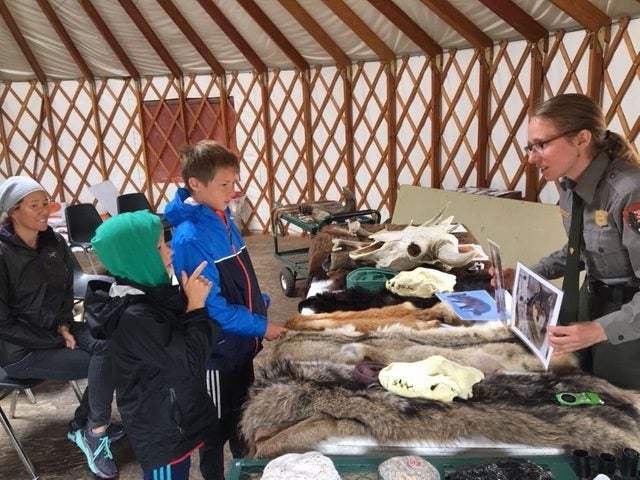Why National Parks Are the Best Summer School

'Lisa Jhung'
Like most outdoor parents, I had heard about the Junior Ranger programs in national parks. But until we arrived in Grand Teton, got our booklets and started digging in, I didn’t realize just how valuable this experience would be for our kids.
Yes, there’s the whole connecting-to-nature, unplugging-from-electronics, sleeping-in-the-great-outdoors education of a trip like this. But because of the Junior Ranger booklets and other great programs in the parks, our kids are learning things they never would have grasped on their own.
I totally underestimated the amount of historical and scientific information the program would be presenting in an enticing, palatable format. I also underestimated the reading, writing and art that would come with working on the Junior Ranger booklets. We’re rounding out the basic school subjects back at camp by strumming the ukulele and guitar by the fire, and playing a lot of blackjack in camp chairs (math!).
But, back to the historical and scientific facts: In Grand Teton, where we spent five nights camped at Jenny Lake, we explored the gorgeous Craig Thomas Discovery and Visitor’s Center and learned all sorts of animal tidbits, reading about the different critters found in various habitats throughout the park.
Some of what they’ve learned has opened their eyes. “Bison are the biggest land mammals,” Sam, 10, informed me after reading about them in his booklet.
“Bison only eat grass,” added Ben, 6. “I thought bison ate meat, like me.”
We did a scavenger hunt at the Colter Bay Visitor Center while exploring their indigenous artifacts display, and took a scenic, and informative, boat ride on Jenny Lake (which reaches it’s deepest point at 250 feet, Sam said, because it was made by a glacier).
On a cold day, we watched a great 55-minute video about the wolf pack in Greater Yellowstone. The film made my eyes water no less than three times because nature is sometimes harsh (did you know that wolves eat coyotes?) but the kids were much tougher.
While in Yellowstone for a quick overnight, we witnessed Old Faithful erupting (“It explodes every 94 minutes or so,” said Sam) and explored the Old Faithful Visitor Education Center, with all sorts of hands-on displays, not unlike a children’s museum.
Once the boys fill out the required pages in their Junior Ranger booklets—each park has their own—and show them to a park ranger at a visitor’s center, they’re sworn in as official Junior Rangers and are handed really cool, park-specific patches that I’ll sew on their backpacks when we get home.
So far, they’ve been sworn in at the beautiful Laurance J. Rockefeller Preserve in Grand Teton and the Albright Visitor Center in Yellowstone’s Mammoth Hot Springs Area in Yellowstone. We’re headed into Glacier National Park tomorrow and will pick up new Junior Ranger booklets there.
I’ve learned a lot on this trip so far, too. Aside from all the cool facts we’ve gleaned from ranger hikes, programs, and nature centers—I didn’t know that elk run with their heads high to appear tough, for instance—I learned most of the lyrics to “Man’s Not Hot.” Sam had a low point on a 3-mile hike one day and I distracted him by asking him to teach me the words to the obscure pop song he’s been singing.
I also learned, at the end of a six-mile hike in the heat, not to dunk your entire head upside down in a creek facing upstream. I’m still getting water out of my ears.
Lesson learned: The national parks are the best school that students of nature could hope for.